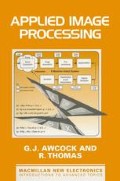Abstract
The feature extraction aspect of image analysis seeks to identify inherent characteristics, or features, of objects found within an image. These characteristics are used to describe the object, or attributes of the object, prior to the subsequent task of classification. Feature extraction operates on two-dimensional image arrays but produces a list of descriptions, or a ‘feature vector’ (note the change in information format indicated on the generic model, section 1.4.1).
Preview
Unable to display preview. Download preview PDF.
References
J. Serra, Image Analysis and Mathematical Morphology, Academic Press, New York, 1982.
G. Matheron, Random Sets and Integral Geometry, Wiley, New York, 1975.
A. Netravali and J. Limb, ‘Picture coding: a review’, Proc. IEEE68, No. 3, pp. 366–406, 1980.
A. Jain, P. Farrelle and V. Algazi, ‘Image data compression’, in M. Ekstrom (Ed.), Digital Image Processing Techniques, Academic Press, New York, 1984.
Various authors, Proc. IEEE 73, No. 2, 1985.
H. Freeman, ‘Computer processing of line-drawing images’, ACM Computing Surveys, 6(1), pp. 57–97, 1974.
R. Courant and H. Robbins, What is Mathematics?, pp. 267–269, Oxford University Press, London, 1941.
K. Dunkelburger and O. Mitchell, ‘Contour tracing for precision measurement’, Proc. Int. Conf. Robotics & Automation, pp. 22–27, IEEE, 1985.
J. Dessimoz and P. Kammenos, ‘Software or hardware for robot vision’, in I. Aleksander (Ed.), Artificial Vision for Robots, Chapter 2, Kogan Page, London, 1983.
H. Blum, ‘A transformation for extracting new descriptors of shape’, in W. Wathen-Dunn (Ed.), Symp. Models for the Perception of Speech and the Visual Form, MIT Press, Cambridge, Massachusetts, 1967.
P. Kitchin and A. Pugh, ‘Processing of binary images’, in A. Pugh (Ed.), Robot Vision, pp. 21–42, IFS (Publications), Bedford, 1983.
R. Gonzalez and R. Woods, Digital Image Processing, 2nd edn, Addison-Wesley, London, 1992.
R. Haralick, Statistical and structural approaches to texture’, Proc. IEEE67, pp. 786–809, 1979.
R. Haralick, Image Texture Analysis, Plenum Press, New York, 1981.
B. Lipkin and A. Rosenfeld (Eds), Picture Processing and Psycho-pictorics, Academic Press, New York, 1970.
M. Hu, ‘Visual pattern recognition by moment invariants’, IRE Trans. Info. Theory, IT-8, pp. 179–187, 1962.
S. Dudani, K. Breeding and R. McGhee, ‘Aircraft identification by moment invariants’, IEEE Trans. Computers, 26(1) pp. 39–46, 1977.
R. Wong and E. Hall, ‘Scene matching with moment invariants’, CGIP, 8, pp. 16–24, 1978.
Author information
Authors and Affiliations
Copyright information
© 1995 G.J. Awcock and R. Thomas
About this chapter
Cite this chapter
Awcock, G.J., Thomas, R. (1995). Feature Extraction. In: Applied Image Processing. Macmillan New Electronics Series. Palgrave, London. https://doi.org/10.1007/978-1-349-13049-8_6
Download citation
DOI: https://doi.org/10.1007/978-1-349-13049-8_6
Publisher Name: Palgrave, London
Print ISBN: 978-0-333-58242-8
Online ISBN: 978-1-349-13049-8
eBook Packages: EngineeringEngineering (R0)

